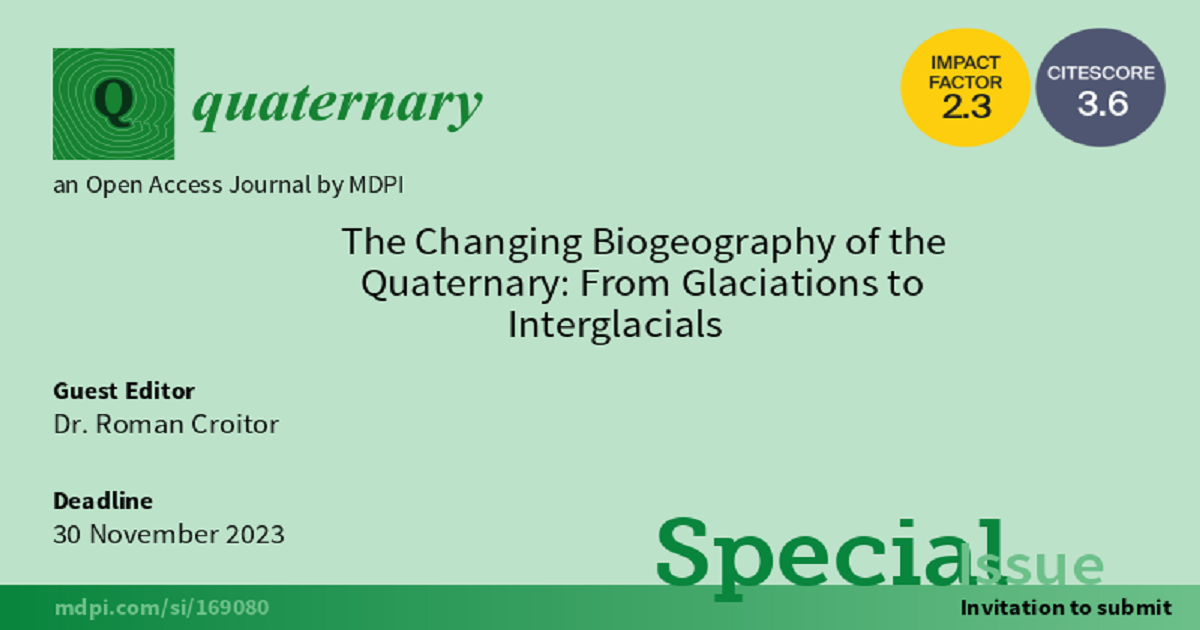The Changing Biogeography of the Quaternary: From Glaciations to Interglacials
A special issue of Quaternary (ISSN 2571-550X).
Deadline for manuscript submissions: closed (30 November 2023) | Viewed by 1096

Special Issue Editor
Special Issue Information
Dear Colleagues,
We are delighted to present this Special Issue of Quaternary, entitled “The Changing Biogeography of the Quaternary: From Glaciations to Interglacials”. This issue aims to provide an up-to-date overview of the paleobiogeographic evolution during the Pleistocene Glacial cycles, which had a profound impact on modern biogeography, biodiversity, and species evolution.
The understanding of evolutionary and paleobiogeographic processes triggered by Pleistocene Glacials and Interglacials is crucial in comprehending the origins of modern biodiversity, biogeographic refugia, as well as the factors that have shaped the current animal and vegetal world. This knowledge is essential in revealing the factors that define the fragility of some modern ecosystems and endangered species.
By correctly understanding the biogeographic transformations in the geologically not-so-remote past and the origin of modern biodiversity, we can gain valuable insights into biogeographic changes under the current climate shifts. This understanding will further contribute to the development of necessary measures and the most adapted strategies for biodiversity preservation.
We hope that this Special Issue will provide readers with a deeper understanding of the paleobiogeographic evolution during the Quaternary, and its relevance to modern biogeography, biodiversity, and conservation.
Best regards,
Dr. Roman Croitor
Guest Editor
Manuscript Submission Information
Manuscripts should be submitted online at www.mdpi.com by registering and logging in to this website. Once you are registered, click here to go to the submission form. Manuscripts can be submitted until the deadline. All submissions that pass pre-check are peer-reviewed. Accepted papers will be published continuously in the journal (as soon as accepted) and will be listed together on the special issue website. Research articles, review articles as well as short communications are invited. For planned papers, a title and short abstract (about 100 words) can be sent to the Editorial Office for announcement on this website.
Submitted manuscripts should not have been published previously, nor be under consideration for publication elsewhere (except conference proceedings papers). All manuscripts are thoroughly refereed through a single-blind peer-review process. A guide for authors and other relevant information for submission of manuscripts is available on the Instructions for Authors page. Quaternary is an international peer-reviewed open access quarterly journal published by MDPI.
Please visit the Instructions for Authors page before submitting a manuscript. The Article Processing Charge (APC) for publication in this open access journal is 1600 CHF (Swiss Francs). Submitted papers should be well formatted and use good English. Authors may use MDPI's English editing service prior to publication or during author revisions.
Keywords
- Pleistocene
- Holocene
- biogeography
- biodiversity
- evolution
- extinctions
Benefits of Publishing in a Special Issue
- Ease of navigation: Grouping papers by topic helps scholars navigate broad scope journals more efficiently.
- Greater discoverability: Special Issues support the reach and impact of scientific research. Articles in Special Issues are more discoverable and cited more frequently.
- Expansion of research network: Special Issues facilitate connections among authors, fostering scientific collaborations.
- External promotion: Articles in Special Issues are often promoted through the journal's social media, increasing their visibility.
- Reprint: MDPI Books provides the opportunity to republish successful Special Issues in book format, both online and in print.
Further information on MDPI's Special Issue policies can be found here.





